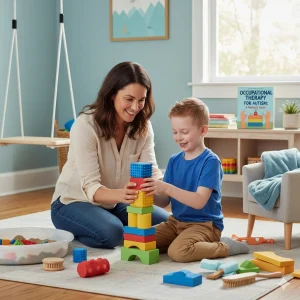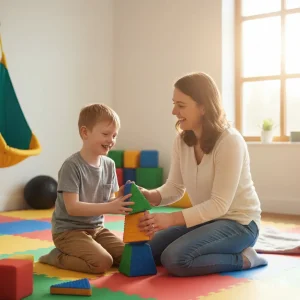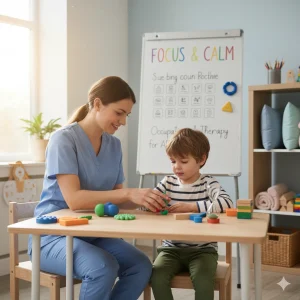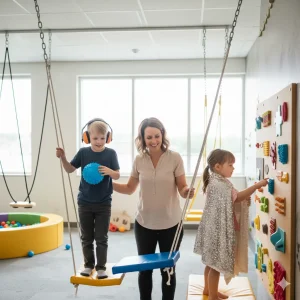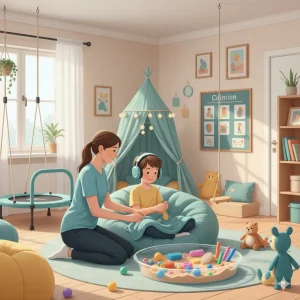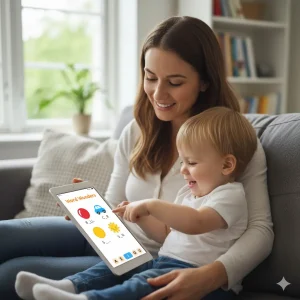Why Your Preschooler Speaks in Short Phrases (and What to Do)
By Wellness Hub
Last Updated: August 20, 2025
Have you noticed your preschooler speaking in incomplete sentences—like saying “want cookie” instead of “I want a cookie”? Or maybe your 3-year-old is still using short phrases while other kids their age are chatting in full sentences. If this sounds familiar, you’re not alone. Many parents worry when their child seems stuck at the two- or three-word stage (telegraphic speech), unsure whether it’s just part of normal development or a sign of an expressive language delay.
Free Speech Help for Kids
Concerned about speech delays? Book a free consultation with our expert speech therapist and get guidance tailored to your child’s needs.
What Age Should a Child Speak in Complete Sentences?
One of the most common questions parents ask is: “When should my child speak in full sentences?” The answer depends on your child’s age, their individual pace of development, and how much language exposure they’ve had at home.
Typical Milestones (Ages 3–4)
By around age 3, most children move beyond single words or two-word phrases and begin putting together 3–5 word sentences. For example, instead of saying “want cookie”, a 3-year-old might say “I want a cookie please.”
By age 4, many children can use longer, more complete sentences with basic grammar, such as:
- “I went to the park with Daddy.”
- “She is playing with the ball.”
According to the CDC (Centers for Disease Control and Prevention) and ASHA (American Speech-Language-Hearing Association), children between 3 and 4 years should:
- Speak in sentences of at least three words
- Begin using past tense and simple grammar rules
- Be understood by familiar adults most of the time
These milestones give a general guide, but remember—children may hit them at slightly different ages.
What Is MLU (Mean Length of Utterance)?
Professionals sometimes measure language growth using something called Mean Length of Utterance (MLU). Don’t worry—it’s not as complicated as it sounds.
MLU simply means the average number of words your child uses in a sentence.
- A 3-year-old might have an MLU of 3–4 words per sentence.
- A 4-year-old may average 4–6 words per sentence.
Tracking MLU helps speech therapists see whether a child is on track for their age or may need extra support.
In short: Most children begin speaking in complete sentences between ages 3 and 4. If your child is still using mostly short phrases past their fourth birthday, it may be worth checking in with a speech-language pathologist (SLP) for guidance.
Is It Normal for a 3-Year-Old to Speak in Incomplete Sentences?
If you’ve noticed your 3-year-old speaking in incomplete sentences, you might be wondering if it’s a cause for concern. The good news is that, in many cases, this can be completely normal. At this age, children are still mastering the building blocks of language, and it’s common for them to use short phrases instead of full sentences.
Understanding Telegraphic Speech
When toddlers say things like “want juice” or “go park,” they’re using what’s called telegraphic speech. This stage usually appears between 18 months and 3 years old. Just like a telegram leaves out unnecessary words, children at this stage focus on the most important parts of a sentence—nouns and verbs—while skipping smaller grammar words like is, the, or a.
Telegraphic speech is a normal part of language development and shows that your child is learning how to combine words into meaningful phrases.
When Short Phrases Are Developmentally Expected
At age 3, it’s perfectly normal for children to still use two- to three-word phrases much of the time. For example:
- “Mommy come play”
- “Want big ball”
- “Go outside now”
By 3 to 3½ years, many kids start adding more detail and moving toward longer, more complete sentences. But if your child is otherwise talking, learning new words, and showing understanding of what you say, using short sentences at this age is usually not a red flag.
Late Talker vs. Speech Delay
It’s important to understand the difference between a late talker and a speech delay:
Late Talker: A child who starts speaking later or uses shorter phrases but is otherwise developing normally. Many late talkers catch up by preschool age without long-term issues.
Speech Delay: A child who consistently struggles to put words together, has very limited vocabulary, or shows difficulty understanding language. This may indicate an expressive language delay or another underlying challenge.
If your child is 3 and mostly using incomplete sentences but continues to learn new words, follows directions, and communicates in other ways, they may simply be a late talker. But if progress seems slow or inconsistent, it may be worth discussing with a speech-language pathologist (SLP) for peace of mind.
Bottom line: Yes, it can be normal for a 3-year-old to speak in incomplete sentences, especially if they’re otherwise developing well. Keep encouraging language growth at home, and remember that every child’s timeline is unique.
Why Preschoolers Speak in Short Phrases or Broken Sentences
If your preschooler often speaks in short phrases, sentence fragments, or broken sentences, it can be both cute and concerning. While some of this is part of normal development, there are a few reasons why children may rely on fragmented speech instead of full, polished sentences.
Receptive vs. Expressive Language Differences
A child’s ability to understand language (receptive) often develops faster than their ability to use language (expressive). For example, your child may understand the sentence “Go get the big red ball from the kitchen” but only respond with “Ball kitchen.” This doesn’t mean they don’t know what you’re saying—it just means their expressive language skills haven’t caught up with what they already understand.
Grammar Development Takes Time
Preschoolers are still learning the building blocks of grammar. That’s why their sentences may look “incomplete” or partial.
- Around age 3, kids may leave out pronouns (“Want cookie” instead of “I want a cookie”).
- By age 3–4, they begin adding -ing words (“running,” “playing”) and plurals (“cats,” “dogs”).
- Past tense verbs (“walked,” “played”) often come in later, sometimes closer to age 4.
This gradual process means their speech may sound like broken sentences as they practice and master each new grammar rule.
Hearing or Oral-Motor Issues
Sometimes, hearing challenges can make it harder for children to pick up sentence patterns. Even mild or frequent ear infections may cause missed sounds and lead to shorter, incomplete sentences. Similarly, oral-motor difficulties—trouble coordinating the lips, tongue, or jaw—can make longer sentences harder to produce, so a child keeps things simple.
Bilingual Preschoolers and Sentence Delays
If your child is learning two languages, you may notice more fragmented speech at first. This is because bilingual children are dividing their learning across two vocabularies and grammar systems. They might mix words from both languages or use shorter, partial sentences as they sort out the rules. The good news? Research shows bilingual kids often catch up quickly and may even have long-term language advantages.
Bottom line: Preschoolers may speak in short phrases, fragments, or broken sentences because their expressive language and grammar skills are still developing—or because of hearing, oral-motor, or bilingual factors. Most of the time, these are just stepping stones on the path to fluent, complete sentences.
Signs of Expressive Language Delay in Preschoolers
By the time children are between 3 and 4 years old, most are starting to use longer, more complete sentences and experimenting with grammar. But if your preschooler seems stuck speaking in short phrases, it may point to an expressive language delay—meaning they have trouble putting their thoughts into words, even if they understand what’s being said to them.
Here are some of the most common signs parents should look for:
1. Understands Language but Doesn’t Speak in Full Sentences
A child with an expressive language delay may follow directions easily—“Bring me your shoes”—but reply with only one or two words like “shoes here” instead of a full sentence. This gap between receptive skills (understanding) and expressive skills (speaking) can be an early red flag.
2. Struggles With Pronouns or Verb Tense
Preschoolers around this age should start using pronouns like he, she, I, they and simple verb tenses (past, present, -ing). A child with expressive language challenges might say:
- “Him go park” instead of “He went to the park.”
- “She running” instead of “She is running.”
These mistakes are common at first, but if they persist beyond age 4, they may indicate a delay.
3. Limited Vocabulary or Echolalia
Most 3- to 4-year-olds should have a growing vocabulary of 200–500 words and be able to use them flexibly in sentences. A child with an expressive delay may:
- Use only a handful of familiar words
- Repeat what others say word-for-word (echolalia) instead of creating their own sentences
- Struggle to recall or name common objects
4. Difficulty Answering WH-Questions
By age 3½–4, children typically begin answering basic “who, what, where, when” questions. If your child repeats the question back, gives unrelated answers, or avoids responding altogether, it could signal expressive language challenges. For example:
- Parent: “What are you eating?”
- Child: “Eating.” (instead of “I’m eating apple.”)
Bottom line: If your preschooler shows several of these signs—especially if they’re 3 or older and still not speaking in full sentences—it may be worth discussing with a speech-language pathologist (SLP). Early support can help children catch up to expected language milestones for ages 3–4 years and build confidence in communication.
When to Worry and Seek Professional Help
It’s normal for parents to wonder: “When should I worry if my child isn’t speaking in full sentences?” While many preschoolers develop language at their own pace, there are certain red flags that suggest it may be time to seek professional guidance.
Red Flags by Age 3
By the time your child turns 3 years old, you should start to see them combining words into short sentences. Worrisome signs include:
- Still relying mostly on single words or very short phrases
- Not adding new words to their vocabulary regularly
- Difficulty being understood by family members most of the time
Red Flags by Age 4
By age 4, most children are able to put together full sentences of 4–6 words. Red flags at this stage include:
- Still speaking in incomplete or fragmented sentences
- Trouble using basic grammar like plurals, pronouns, or past tense
- Struggling to answer simple questions (e.g., “What’s your name?” or “Where’s your toy?”)
- Becoming frustrated when trying to communicate
When to Consult a Speech-Language Pathologist (SLP)
If your child shows several of these signs, it’s a good idea to consult a speech-language pathologist (SLP). An SLP can:
- Assess your child’s expressive and receptive language skills
- Identify whether delays are mild, moderate, or significant
- Create a play-based therapy plan to encourage longer, more complete sentences
Early intervention often makes a big difference, helping children catch up to expected milestones before starting school.
Role of Developmental Screening and Hearing Evaluation
Sometimes what looks like a speech delay may be linked to other factors. Professionals may recommend:
- Developmental screening – to check overall growth, including social and cognitive skills
- Hearing evaluation – since even mild hearing loss or frequent ear infections can make it harder for children to learn sentence patterns
These steps help rule out underlying issues and ensure your child receives the right support.
Bottom Line
If you’re wondering when to see a speech therapist for your preschooler, trust your instincts.
- If your child is 3 and not yet combining words into short sentences, or
- If your child is 4 and still not speaking in full sentences…
…it’s best to seek guidance early. Support from an SLP, combined with simple strategies at home, can help your child find their voice with confidence.
How to Help Your Child Speak in Complete Sentences
If your preschooler often talks in short phrases, you may be wondering how to encourage complete sentences in preschoolers at home. The good news is, everyday routines and playtime provide perfect opportunities to help your child grow from “want cookie” to “I want a cookie, please.” With patience and the right strategies, you can gently expand their language skills.
Modeling and Recasting Short Sentences
One of the simplest and most effective techniques is modeling. When your child says “dog run,” you can respond with, “Yes, the dog is running fast!” This shows them how to build on their idea without forcing them to repeat after you.
Recasting works the same way—you take what your child says and reshape it into a slightly longer or more complete version. For example:
- Child: “Want ball.”
- Parent: “You want the red ball.”
Over time, your child begins to absorb these patterns and naturally lengthens their sentences.
Everyday Sentence-Building Activities
Daily life is full of chances to practice:
- Books: Pause while reading a story and ask your child to describe the picture: “What is the boy doing?” Encourage them to answer in a full sentence.
- Playtime: While playing with blocks or dolls, model sentences: “The doll is sleeping in the bed.”
- Role Play: Pretend play (shop, doctor, kitchen) encourages children to use longer, more natural sentences.
These fun activities not only build vocabulary but also help children practice sentence structure in context.
Using Expansion Strategies
Expansion means taking your child’s simple phrase and adding one or two more words.
- Child: “Truck big.”
- Parent: “Yes, the truck is very big.”
- Child: “Go park.”
- Parent: “We are going to the park after lunch.”
By gently expanding, you help your child hear how full sentences sound without overwhelming them.
Fun Speech Therapy Apps and Games
Technology can also play a supportive role. Child-friendly speech therapy apps and games turn sentence practice into a fun activity. Apps like the BASICS App use interactive visuals, speech modeling, and simple rewards to encourage children to expand sentences step by step. When combined with parent involvement, these tools can make language practice feel more like play than work.
Bottom line: Helping your preschooler move from short phrases to complete sentences doesn’t require drills or pressure. With consistent modeling, playful activities, expansion strategies, and engaging apps, you can make sentence-building a natural part of your daily routine—while giving your child the confidence to express themselves fully.
Conclusion
It’s common for young children to use short phrases or incomplete sentences when they are first learning to talk. By age 3, many kids begin speaking in 3–5 word sentences, and by age 4 most can form complete sentences. If your child is past 4 and still speaks in fragments or struggles with grammar, it may be a sign of an expressive language delay. Don’t wait—early help makes a big difference. A speech-language pathologist (SLP) can guide you.
Frequently Asked Questions:
1. At what age should a child start speaking in full sentences?
Most children begin combining words into 3–5 word sentences by age 3. For example, instead of saying “want cookie,” a 3-year-old might say “I want cookie please.” By age 4, children typically use longer sentences of 4–6 words with simple grammar, such as “I went to the park with Daddy.” Keep in mind, every child develops at their own pace, but if your child is past 4 and still not speaking in full sentences, it may be worth checking in with a professional.
2. Is it normal for a 3-year-old to speak in incomplete sentences?
Yes, it’s very common for a 3-year-old to use incomplete or short sentences. This stage is called telegraphic speech, where children focus on the most important words (like nouns and verbs) and leave out smaller grammar words such as “is” or “the.” For example, “Go park” instead of “I want to go to the park.” This shows your child is learning how to put words together, and for many kids, it’s a normal step in language development.
3. When should I worry if my child is not speaking in full sentences?
You should start to pay closer attention by age 4. If your child:
- Still speaks mostly in two- or three-word fragments
- Doesn’t add new words regularly
- Struggles with basic grammar like plurals or pronouns
- Has trouble answering simple questions
—these could be signs of an expressive language delay. While some children catch up naturally, it’s always best to seek reassurance from a speech-language pathologist (SLP) rather than waiting.
4. What is telegraphic speech in toddlers?
Telegraphic speech happens when children speak in short, clipped phrases that leave out little grammar words. For example:
- “Want juice” instead of “I want juice.”
- “Mommy play” instead of “Mommy is playing.”
This is normal for toddlers between 18 months and 3 years, and it shows they are progressing from single words to putting words together. By around 3½ to 4 years, most kids move beyond this stage.
5. How can I help my preschooler speak in complete sentences?
You can encourage full sentences through simple, everyday strategies:
- Modeling: When your child says “dog run,” respond with “Yes, the dog is running fast.”
- Expansion: Add a word or two to their phrase. “Want ball” → “You want the red ball.”
- Books and stories: Pause and ask questions like “What is the boy doing?” to encourage longer answers.
- Play and role play: Pretend games like shop or kitchen naturally lead to sentence-building practice.
- Apps and games: Child-friendly speech apps like BASICS make sentence practice fun with visuals and rewards.
6. What are signs of an expressive language delay?
Some clear signs include:
- A child who understands directions but doesn’t reply in full sentences
- Struggles with pronouns (he, she, they) or verb tenses (is running, walked)
- Has a limited vocabulary for their age or repeats others’ words (echolalia)
- Trouble answering “who, what, where” questions
If your child is showing several of these signs between ages 3–4, it’s a good idea to talk to an SLP for further support.
7. Do bilingual children start speaking in sentences later?
Yes, sometimes bilingual preschoolers may use shorter or mixed sentences at first, because they’re learning two sets of vocabulary and grammar rules. For example, they might combine words from both languages or simplify sentence structure. This doesn’t mean there’s a problem—research shows bilingual children usually catch up quickly and often have long-term advantages in thinking and language flexibility.
8. Can hearing problems cause speech delays?
Yes. Even mild hearing loss—such as from frequent ear infections—can affect how children hear and copy sounds. If they don’t hear words clearly, they may struggle to build longer, complete sentences. That’s why hearing tests are often recommended if speech delays are suspected. Once hearing is treated or supported, many children quickly improve in their speech.
9. Should I correct my child’s incomplete sentences?
Instead of correcting, use gentle modeling and recasting. For example:
- Child: “Want cookie.”
- Parent: “Oh, you want a cookie. I want a cookie too!”
This approach shows your child how a full sentence sounds without putting pressure on them. Over time, they naturally copy your longer sentences.
10. When should I see a speech-language pathologist (SLP)?
It’s best to see an SLP if:
- Your child is 3 and not combining words into short sentences
- Your child is 4 and still not speaking in complete sentences
- You notice ongoing frustration with communication
An SLP can assess your child’s skills, check for underlying issues, and create a play-based plan to help them succeed. Early intervention is key—children often make faster progress when they get support sooner.
About the Author:
Shilpa Deshpande
Shilpa Deshpande is a skilled speech-language pathologist with over 14 years of experience. Fluent in Kannada, Telugu, Hindi, and English, she specializes in parent counseling, speech sound disorders, fluency assessment, and speech-language evaluations. Shilpa excels at working with children with developmental disorders, offering creative and effective therapy programs. Currently, at Wellness Hub, she holds a BASLP degree and is registered with the RCI. Her patience, ambition, and dedication make her a trusted expert in her field.
Book your Free Consultation Today
Parent/Caregiver Info:
Client’s Details:
* Error Message

